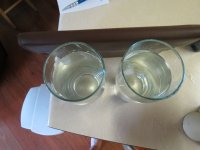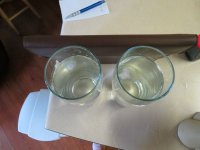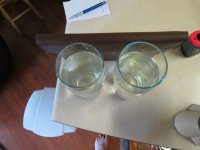I know the specific heat of salt water is lower than fresh, don't know if that affects the heat transfer, but my gut says it would. Less energy to cool down the salt water near the cube means slower melting. On the other hand, specific heat is per mass, and salt water is heavier so a volume of each May have the same heat capacity.
On the other hand
Specific heat of salt is 1/5th of water, 20% higher specific mass.
=> for the same volume, ~1/4th specific heat number of water.
(specific heat of seawater is 5% lower than freshwater)
Idea of putting ice cubes in a glass, is that heat exchange between cubes and liquid is higher than between liquid and ambient.
Since salt water is more dense, the ice cube will float higher, exposing less surface to the water, reducing heat transfer. Very minor effect though, I should think.
One interesting thing has shown up already. The glass with the salt now dissolved is a lower temperature than the fresh even though the room is warmer than both so I will wait till they equalize.
Attachments
Agreed, but will this reduce heat transfer? when the fresh water cube melts, it gives up fresh water obviously, and this very cold water will tend to stay confined near the surface, in the immediate vicinity of the cube, because it is lighter than brine and therefore cannot sink and promote convection.Since salt water is more dense, the ice cube will float higher, exposing less surface to the water, reducing heat transfer.
This will create a cold, relatively insulating layer or shell within the liquid.
On the other hand, the emerged part of the cube will be exposed to the air, and there will be some convection (or inverse convection) acting.
If the container is not filled up to the rim, there will also be some similar blockage, when all the available space has been filled by chilled air, but if it is filled to the rim or thereabout, the process will continue and inject heat into the cube.... some more parameters to consider
since salt lowers the melting point (E.g. the "phase change" thus exists at a lower temp ) energy needs to be released (edit absorbed in this case). and feels colder.One interesting thing has shown up already. The glass with the salt now dissolved is a lower temperature than the fresh even though the room is warmer so I will have to wait till they equalize.
look up 'phase change' solid to a liquid in this case
I didn't look anything up I just remembered this from school and why salt is added to ice cream making devices
Last edited:
Salt 35 grams
Water 500 ml.
It tastes really salty. Uh, never mind.
That's what she...
Right. Never mind. 😀
I was surprised that it took 5 minutes for the fresh water and a full 18 minutes for the salted, to melt the cube.
God I need a life
God I need a life

Thermal conductivity of water and saline is about the same, so the first instinct is to think the cube should melt at the same rate. And, if the liquid was moving in a flow past the cube the rate would be the same. However, in a glass, the molten ice has two properties: 1 it is colder than surrounding fluid 2 it has lower density than saline. So how fast the molten ice water leaves the vicinity of the cube after it has melted depends on its relative density versus fresh water at room temperature, and versus saline. In the case of fresh water it sinks, in the case of saline it floats. Therefore the thermal gradient within the fluid of the glass is different, and heat flow out of the ice cube is greater in the case of fresh water, so it melts faster. Ta da.
Hi,
Its redolent of the adolescent that claimed hotter water freezed
faster than colder water in his experiments. Roundly condemned
as thermodynamic nonsense, it turned out in the end to be true,
due to the hotter water setting up currents the colder water didn't.
rgds, sreten.
Its redolent of the adolescent that claimed hotter water freezed
faster than colder water in his experiments. Roundly condemned
as thermodynamic nonsense, it turned out in the end to be true,
due to the hotter water setting up currents the colder water didn't.
rgds, sreten.
And the explanation is...?
Less heat has to be drawn from the salted water to drop the temperature by 1 point.
Means temperature of the salted water will be lower than the freshwater.
Also means that temperature difference between the ice and the salt water will be smaller at the same moment.
Thermodynamics 101 : heat transfer has a linear relationship with temperature difference in degrees.
Temperature difference between the salted water and ambient air will increase faster than for the freshwater.
But thermal transfer to air is lousy ! (in particular when air is surrounded by a wall of glass, and the water surface is dead, zero movement)
Last edited:
Im a formulation chemist don't bother me with such childs play~
Phenol red has an indicator pH range of 6.8 to 8.4. Its acid color is yellow and basic color is red. In 0.10 M NaOH, this indicator will exhibit what color?
Here is an easier question.
Why would contact with steam at 100 C produce a more severe burn than contact with liquid water at the same temperature?
Phenol red has an indicator pH range of 6.8 to 8.4. Its acid color is yellow and basic color is red. In 0.10 M NaOH, this indicator will exhibit what color?
Here is an easier question.
Why would contact with steam at 100 C produce a more severe burn than contact with liquid water at the same temperature?
Last edited:
- Status
- Not open for further replies.
- Home
- Member Areas
- The Lounge
- Melting ice in liquid
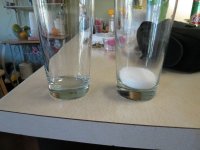
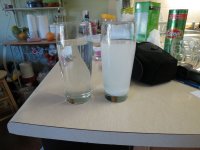

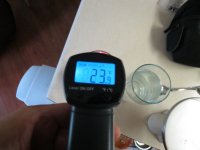
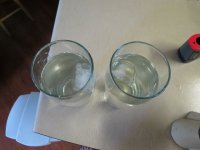
 most every night wishing I was more interesting.
most every night wishing I was more interesting.